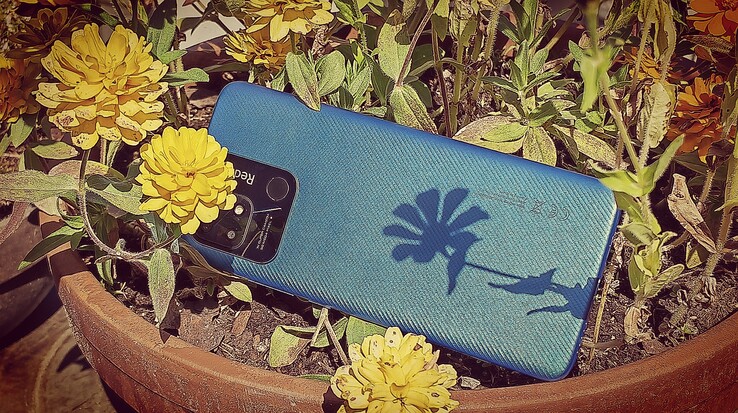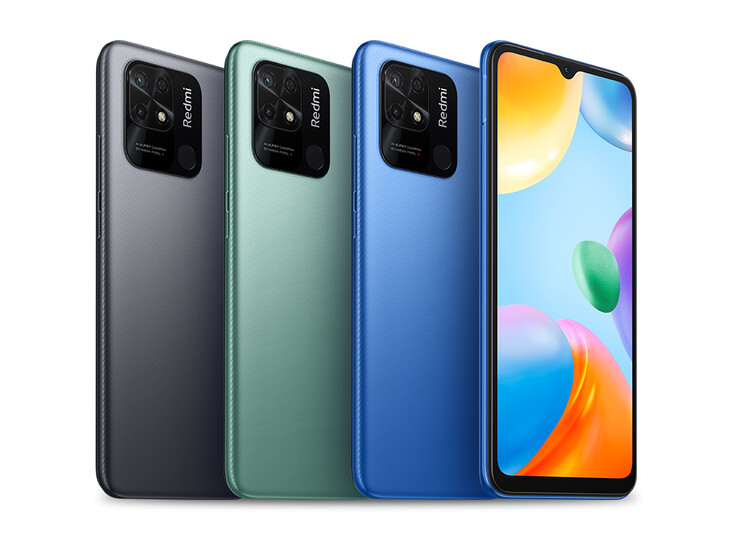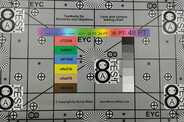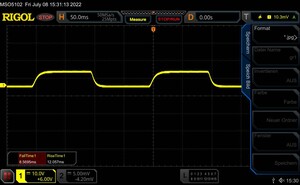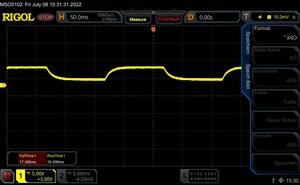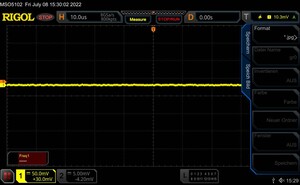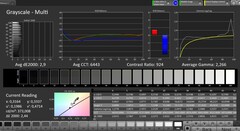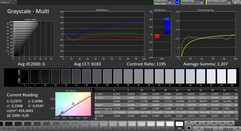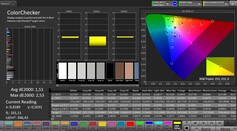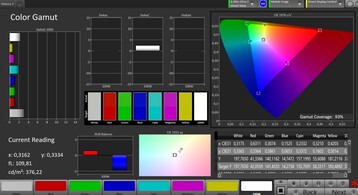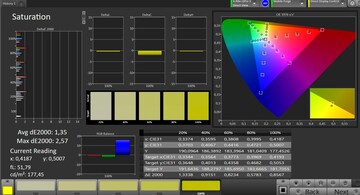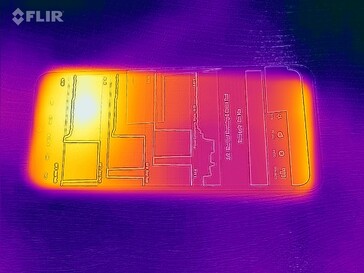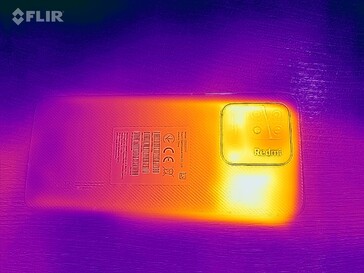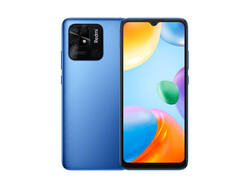Xiaomi Redmi 10C Smartphone Review - Great color reproduction for the entry-level phone
Possible competitors in comparison
Rating | Date | Model | Weight | Drive | Size | Resolution | Price |
|---|---|---|---|---|---|---|---|
| 76.6 % v7 (old) | 07 / 2022 | Xiaomi Redmi 10C SD 680, Adreno 610 | 190 g | 64 GB UFS 2.2 Flash | 6.71" | 1650x720 | |
| 75.1 % v7 (old) | 05 / 2022 | Motorola Moto G22 Helio G37, PowerVR GE8320 | 185 g | 64 GB eMMC Flash | 6.50" | 1600x720 | |
| 80 % v7 (old) | 05 / 2022 | Xiaomi Redmi Note 11 SD 680, Adreno 610 | 179 g | 64 GB UFS 2.2 Flash | 6.43" | 2400x1080 | |
| 75.8 % v7 (old) | 07 / 2022 | Samsung Galaxy M13 Exynos 850, Mali-G52 MP1 | 192 g | 64 GB eMMC Flash | 6.60" | 2408x1080 | |
| 73.8 % v7 (old) | 01 / 2022 | Xiaomi Redmi 9C Helio G35, PowerVR GE8320 | 196 g | 128 GB eMMC Flash | 6.53" | 1600x720 |
Case and features - Protected by Gorilla Glass
Even though the Redmi 10C is currently offered at a discount almost everywhere, the manufacturer's recommended retail price is as follows:
- 64 GB mass storage / 3 GB RAM: 169.90 euros
- 64 GB mass storage / 4 GB RAM: 179.90 euros
- 128 GB mass storage / 4 GB RAM: 199.90 Euro
At the time of the test, the largest version was only available from online retailers like amazon.de, and the 64 GB variants also from Xiaomi directly. The price difference with the Redmi Note 11 is 20 to 30 Euros for the same memory configuration.
The Redmi 10C comes in a plastic casing, which also makes quite an impression with its bulky camera module, even though there is a lot of show here because the Xiaomi Redmi 10C actually only includes a single camera. A diagonal pattern that is also haptically noticeable runs across the matte glossy back, which hides fingerprints quite cleverly, at least in our blue test device. Other color options are green and gray.
The casing is very solidly built with small gaps, and Gorilla Glass 3 protects the screen. Pressure on the casing only partially gets through to the screen, otherwise, the smartphone looks resistant.
NFC for mobile payment services is on board, as is Bluetooth 5.0. The microSD reader can be used in addition to 2 SIM cards. In our tests with the reference microSD Angelbird V60, the smartphone performs quite well, reading and writing to the card very quickly.
| SD Card Reader - average JPG Copy Test (av. of 3 runs) | |
| Xiaomi Redmi 10C (Angelbird V60) | |
| Average of class Smartphone (5.72 - 58.9, n=67, last 2 years) | |
| Samsung Galaxy M13 (Angelbird V60) | |
| Xiaomi Redmi Note 11 (Angelbird AV Pro V60) | |
| Motorola Moto G22 (Angelbird V60) | |
| Xiaomi Redmi 9C (Angelbird V60) | |
Cross Platform Disk Test (CPDT)
Communication, software and operation - Updates until 2025
WiFi 5 is on board, which is usual for this price range. Compared with its predecessor, the Redmi 10C now has a significant speed advantage in WLAN speed over the Redmi 9C, and other devices in the price range, such as the Moto G22, transfer data even a bit faster.
The available 4G frequencies are sufficient for traveling to European countries, but the Redmi 10C cannot be used for mobile Internet worldwide. The reception is average in our test and cannot always keep up with high-end smartphones. 5G is usually only available in phones with an MSRP of over 200 Euros (~$200), so the Redmi 10C also has to do without it.
MIUI 13 based on Android 11 is preinstalled on the Redmi 10C. The security patches are from the beginning of June 2022 and are thus still quite up-to-date. Android 12 is still supposed to come this year. There will be another Android version, and security update every 90 days until February 2025.
The 60 Hz screen is easy to use and is also sensitive in the corners. The fingerprint sensor is unusually integrated into the camera module. Lefties will have a bit more difficulty reaching it with the index finger than righties. The scanner unlocks the smartphone reliably after a short wait even from standby. 2D face recognition can also be used for unlocking. The software solution also works quite well in environments with less light, but it can be tricked out so that it is not as secure.
| Networking | |
| iperf3 transmit AX12 | |
| Xiaomi Redmi 9C | |
| iperf3 receive AX12 | |
| Xiaomi Redmi 9C | |
| iperf3 transmit AXE11000 | |
| Motorola Moto G22 | |
| Samsung Galaxy M13 | |
| Xiaomi Redmi Note 11 | |
| Xiaomi Redmi 10C | |
| iperf3 receive AXE11000 | |
| Motorola Moto G22 | |
| Samsung Galaxy M13 | |
| Xiaomi Redmi Note 11 | |
| Xiaomi Redmi 10C | |
Cameras - Only one usable lens
The 50-megapixel sensor of the main camera is Samsung's ISOCELL JN1, which is also used in the Redmi Note 11. The Redmi 10C does not have a wide-angle camera, and the macro lens from the predecessor has also been omitted. Only a support lens for the depth of field in portraits is still available.
Photos from the Redmi 10C are a bit lacking in dynamics, so bright areas quickly get overbright, while photos look dark in bad weather. In very low light, the Redmi 10C does manage decent brightening, but at the price of heavy image noise. Details look quite coarse when zoomed in.
Videos can be recorded in 1080p and 30 fps at most. Brightness adjustment works slightly delayed, but overall well. The autofocus also works decently but needs a bit of adjustment.
The front-facing camera has a resolution of 5 megapixels and takes decent pictures that look a bit coarse even without magnification. You can see a clear graininess of surfaces in detail and hardly any fine structures are visible in dark areas.
Image comparison
Choose a scene and navigate within the first image. One click changes the position on touchscreens. One click on the zoomed-in image opens the original in a new window. The first image shows the scaled photograph of the test device.
Main cameraMain cameraLow Light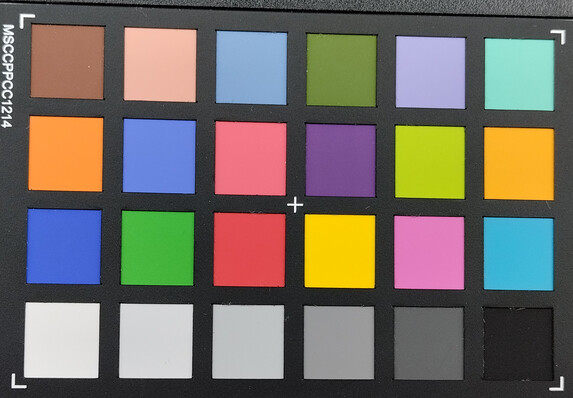
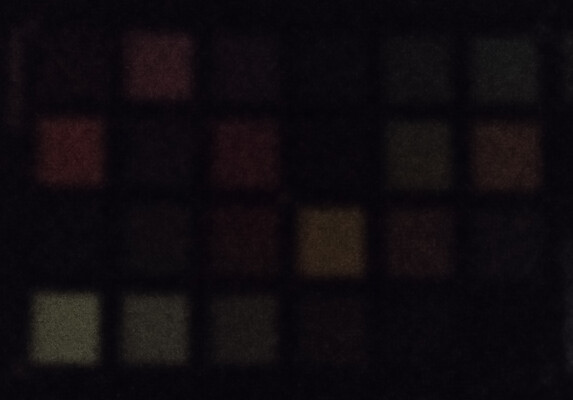
Display - Only 720p and 60 Hz, but without PWM
The IPS screen has a resolution of 720p. For a little extra, you get the Redmi Note 11 that already has a 1080p OLED screen, and the Galaxy M13 can also shine with a higher resolution, but it also relies on an LCD screen.
The screen's brightness in the Redmi 10C is sufficient for everyday use, and you even get very accurate colors on the screen when you select "Standard" as the color scheme. The response times will be too long for gamers, but at least we did not measure any PWM flickering, which is a problem in the Redmi Note 11 is present.
| |||||||||||||||||||||||||
Brightness Distribution: 84 %
Center on Battery: 511 cd/m²
Contrast: 1217:1 (Black: 0.42 cd/m²)
ΔE ColorChecker Calman: 1.51 | ∀{0.5-29.43 Ø4.78}
ΔE Greyscale Calman: 2.9 | ∀{0.09-98 Ø5}
93% sRGB (Calman 2D)
Gamma: 2.266
CCT: 6443 K
| Xiaomi Redmi 10C IPS, 1650x720, 6.7" | Motorola Moto G22 IPS LCD, 1600x720, 6.5" | Xiaomi Redmi Note 11 OLED, 2400x1080, 6.4" | Samsung Galaxy M13 PLS, 2408x1080, 6.6" | Xiaomi Redmi 9C IPS, 1600x720, 6.5" | |
|---|---|---|---|---|---|
| Response Times | -51% | 95% | 26% | -72% | |
| Response Time Grey 50% / Grey 80% * (ms) | 33 ? | 46 ? -39% | 1.135 ? 97% | 27 ? 18% | 60 ? -82% |
| Response Time Black / White * (ms) | 21 ? | 34 ? -62% | 1.635 ? 92% | 14 ? 33% | 34 ? -62% |
| PWM Frequency (Hz) | 171.4 | 17120 | |||
| Screen | -86% | 33% | -66% | -74% | |
| Brightness middle (cd/m²) | 511 | 451 -12% | 702 37% | 481 -6% | 467 -9% |
| Brightness (cd/m²) | 478 | 431 -10% | 701 47% | 444 -7% | 417 -13% |
| Brightness Distribution (%) | 84 | 90 7% | 98 17% | 85 1% | 83 -1% |
| Black Level * (cd/m²) | 0.42 | 0.5 -19% | 0.43 -2% | 0.53 -26% | |
| Contrast (:1) | 1217 | 902 -26% | 1119 -8% | 881 -28% | |
| Colorchecker dE 2000 * | 1.51 | 5.82 -285% | 1 34% | 4.55 -201% | 4.14 -174% |
| Colorchecker dE 2000 max. * | 2.53 | 9.3 -268% | 2.3 9% | 7.86 -211% | 8.49 -236% |
| Greyscale dE 2000 * | 2.9 | 5 -72% | 1.4 52% | 5.5 -90% | 6 -107% |
| Gamma | 2.266 97% | 2.776 79% | 2.2 100% | 2.233 99% | 2.291 96% |
| CCT | 6443 101% | 7683 85% | 6520 100% | 7969 82% | 7536 86% |
| Total Average (Program / Settings) | -69% /
-79% | 64% /
48% | -20% /
-47% | -73% /
-74% |
* ... smaller is better
Display Response Times
| ↔ Response Time Black to White | ||
|---|---|---|
| 21 ms ... rise ↗ and fall ↘ combined | ↗ 9 ms rise | |
| ↘ 12 ms fall | ||
| The screen shows good response rates in our tests, but may be too slow for competitive gamers. In comparison, all tested devices range from 0.1 (minimum) to 240 (maximum) ms. » 45 % of all devices are better. This means that the measured response time is similar to the average of all tested devices (20.2 ms). | ||
| ↔ Response Time 50% Grey to 80% Grey | ||
| 33 ms ... rise ↗ and fall ↘ combined | ↗ 17 ms rise | |
| ↘ 16 ms fall | ||
| The screen shows slow response rates in our tests and will be unsatisfactory for gamers. In comparison, all tested devices range from 0.165 (minimum) to 636 (maximum) ms. » 44 % of all devices are better. This means that the measured response time is similar to the average of all tested devices (31.6 ms). | ||
Screen Flickering / PWM (Pulse-Width Modulation)
| Screen flickering / PWM not detected | |||
In comparison: 53 % of all tested devices do not use PWM to dim the display. If PWM was detected, an average of 8101 (minimum: 5 - maximum: 343500) Hz was measured. | |||
Performance, emissions and battery life - Too weak charger
In terms of performance, the Redmi 10C can make a significant leap compared with its predecessor. On the one hand, this is due to the much faster UFS 2.2 memory, which shortens charging and waiting times, and on the other hand, the Snapdragon 680, which delivers good performance for the price range. There are even advantages in gaming due to the lower resolution of the display, so you get a few frames more than in the Redmi Note 11, which is also equipped with the Snapdragon 680.
Overall, you should not expect miracles in everyday use, but it is usually enough for smooth system operation. However, you have to make some concessions in the perceived reactivity of the operation due to the 60 Hz screen. The smartphone hardly heats up even under a continuous load.
The small mono speaker on the bottom edge can hardly reproduce low mids, but it is quite balanced in the treble range even at maximum volume, so you can definitely listen to music. A 3.5 mm port for headphones is available, as is Bluetooth 5.0, which can use a variety of codecs including LHDC and aptX TWS+.
The smartphone could handle 18 watts of charging power, but unfortunately only a 10-watt charger is included in the package. That is weak from Xiaomi and potentially creates additional e-waste if customers want to buy a faster charger on top of that. With the included charger, it also takes well over 2:30 hours to fill up the 5,000 mAh battery; with a faster charger, you can reduce the charging time to about 2 hours.
With a full battery, it is possible to surf the WLAN for about 15 hours before the phone has to be plugged in again. This is a value typical for the class and on a very similar level to the predecessor. depending on the usage, 2 days without a battery charge seems realistic.
| Xiaomi Redmi 10C | Motorola Moto G22 | Xiaomi Redmi Note 11 | Samsung Galaxy M13 | Xiaomi Redmi 9C | Average 64 GB UFS 2.2 Flash | Average of class Smartphone | |
|---|---|---|---|---|---|---|---|
| AndroBench 3-5 | -79% | 7% | -71% | -67% | -5% | 156% | |
| Sequential Read 256KB (MB/s) | 927.7 | 215.45 -77% | 895.34 -3% | 264.5 -71% | 263.1 -72% | 770 ? -17% | 2228 ? 140% |
| Sequential Write 256KB (MB/s) | 510.2 | 112.78 -78% | 519.23 2% | 193.5 -62% | 208.4 -59% | 399 ? -22% | 1852 ? 263% |
| Random Read 4KB (MB/s) | 120.2 | 39.32 -67% | 172.95 44% | 42.5 -65% | 54.5 -55% | 156.6 ? 30% | 296 ? 146% |
| Random Write 4KB (MB/s) | 195.2 | 16.34 -92% | 163.29 -16% | 30.3 -84% | 39.7 -80% | 177.7 ? -9% | 339 ? 74% |
Temperature
(+) The maximum temperature on the upper side is 37.7 °C / 100 F, compared to the average of 35.2 °C / 95 F, ranging from 21.9 to 247 °C for the class Smartphone.
(+) The bottom heats up to a maximum of 38.7 °C / 102 F, compared to the average of 34 °C / 93 F
(+) In idle usage, the average temperature for the upper side is 28.4 °C / 83 F, compared to the device average of 32.9 °C / 91 F.
Speaker
Xiaomi Redmi 10C audio analysis
(±) | speaker loudness is average but good (79.3 dB)
Bass 100 - 315 Hz
(-) | nearly no bass - on average 32% lower than median
(±) | linearity of bass is average (8.8% delta to prev. frequency)
Mids 400 - 2000 Hz
(±) | reduced mids - on average 5.1% lower than median
(+) | mids are linear (6.3% delta to prev. frequency)
Highs 2 - 16 kHz
(+) | balanced highs - only 2.4% away from median
(+) | highs are linear (5% delta to prev. frequency)
Overall 100 - 16.000 Hz
(±) | linearity of overall sound is average (23.9% difference to median)
Compared to same class
» 54% of all tested devices in this class were better, 9% similar, 37% worse
» The best had a delta of 11%, average was 35%, worst was 134%
Compared to all devices tested
» 71% of all tested devices were better, 7% similar, 23% worse
» The best had a delta of 4%, average was 24%, worst was 134%
Samsung Galaxy M13 audio analysis
(±) | speaker loudness is average but good (81.4 dB)
Bass 100 - 315 Hz
(-) | nearly no bass - on average 26.3% lower than median
(±) | linearity of bass is average (12% delta to prev. frequency)
Mids 400 - 2000 Hz
(±) | higher mids - on average 6.1% higher than median
(+) | mids are linear (6% delta to prev. frequency)
Highs 2 - 16 kHz
(±) | higher highs - on average 7.2% higher than median
(±) | linearity of highs is average (7.8% delta to prev. frequency)
Overall 100 - 16.000 Hz
(±) | linearity of overall sound is average (25.6% difference to median)
Compared to same class
» 63% of all tested devices in this class were better, 7% similar, 30% worse
» The best had a delta of 11%, average was 35%, worst was 134%
Compared to all devices tested
» 78% of all tested devices were better, 5% similar, 17% worse
» The best had a delta of 4%, average was 24%, worst was 134%
Battery life
| Battery Runtime - WiFi Websurfing | |
| Average of class Smartphone (12.1 - 54.1, n=209, last 2 years) | |
| Motorola Moto G22 | |
| Xiaomi Redmi 10C | |
| Xiaomi Redmi 9C | |
| Samsung Galaxy M13 | |
| Xiaomi Redmi Note 11 | |
Pros
Cons
Verdict - Savings on the equipment
The Xiaomi Redmi 10C is an inexpensive smartphone under 200 Euros (~$200) that offers quite a bit of system performance for its class. The battery runtime convinces us. Furthermore, the phone hardly heats up even under load and can display quite accurate colors on its screen with the right settings.
It is annoying that Xiaomi includes a weak charger, preloads numerous advertising apps, and only installs a 60 Hz panel. There are better examples in this price range.
The Xiaomi Redmi 10C is a phone for budget buyers with somewhat spartan features. However, performance and battery life are convincing.
Yes, you save a few Euros with the Redmi 10C compared to the Redmi Note 11. But if you do not mind the flickering of the AMOLED screen, you will get a wide-angle camera, a higher display resolution, faster frame rates, faster charging, and faster Wi-Fi.
Price and availability
In Xiaomi's online shop you can get the 64 GB versions of the phone with a 20 euro discount on the RRP at the time of the test, i.e. for approximately 150 and 160 euros, respectively.
Similar offers are also available on the Internet at the time of the test, for example at our loaner notebooksbilliger.de or amazon.de
The variant with 128 GB data storage is available from various internet retailers for about 160 Euros, for example, amazon.de.
Xiaomi Redmi 10C
- 07/21/2022 v7 (old)
Florian Schmitt




